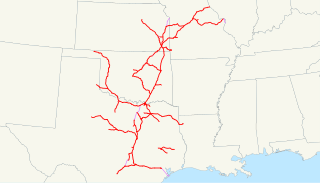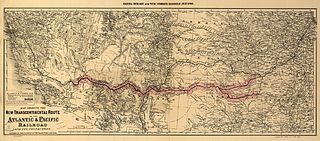Related Research Articles

BNSF Railway is the largest freight railroad in the United States. One of six North American Class I railroads, BNSF has 36,000 employees, 33,400 miles (53,800 km) of track in 28 states, and over 8,000 locomotives. It has three transcontinental routes that provide rail connections between the western and eastern United States. BNSF trains traveled over 169 million miles in 2010, more than any other North American railroad.

The Missouri–Kansas–Texas Railroad was a Class I railroad company in the United States, with its last headquarters in Dallas, Texas. Established in 1865 under the name Union Pacific Railroad (UP), Southern Branch, it came to serve an extensive rail network in Texas, Oklahoma, Kansas, and Missouri. In 1988, it merged with the Missouri Pacific Railroad; today, it is part of UP.

The St. Louis–San Francisco Railway, commonly known as the "Frisco", was a railroad that operated in the Midwest and South Central United States from 1876 to November 21, 1980. At the end of 1970, it operated 4,547 miles (7,318 km) of road on 6,574 miles (10,580 km) of track, not including subsidiaries Quanah, Acme and Pacific Railway and the Alabama, Tennessee and Northern Railroad; that year, it reported 12,795 million ton-miles of revenue freight and no passengers. In 1980 it was purchased by and absorbed into the Burlington Northern Railroad. Despite its name, it never came close to San Francisco.
The Oklahoma Railway Company (ORy) operated interurban lines to El Reno, Guthrie, and Norman, and several streetcar lines in Oklahoma City and the surrounding area from 1904 to 1947.
The Midland Valley Railroad (MV) was a railroad company incorporated on June 4, 1903 for the purpose of building a line from Hope, Arkansas, through Muskogee and Tulsa, Oklahoma to Wichita, Kansas. It was backed by C. Jared Ingersoll, a Philadelphia industrialist who owned coal mining properties in Indian Territory. The railroad took its name from Midland, Arkansas, a coal mining town in western Arkansas, which was served by the railroad. The Midland Valley gained access to Fort Smith, Arkansas via trackage rights over the Frisco from Rock Island, Oklahoma.

The Wichita, Tillman and Jackson Railway is a shortline railroad subsidiary of the Rio Grande Pacific Corporation that operates in Oklahoma and Texas. The line for which it is named extends from Wichita Falls, Texas to just north of Altus, Oklahoma, through Wichita County, Texas, Tillman County, Oklahoma, and Jackson County, Oklahoma. It interchanges with the Union Pacific (UP) and BNSF at Wichita Falls, with Farmrail (FMRC), Stillwater Central Railroad (SLWC), and the BNSF at Altus, and with Grainbelt (GNBC) at Frederick, Oklahoma. It carries predominantly grain, chemicals and agricultural products.
The Kansas, Oklahoma and Gulf Railway (“KO&G”) had at its height 310.5 miles of track from Denison, Texas through Oklahoma to Baxter Springs, Kansas. Its various predecessor companies built the line between 1904 and 1913. The railroad was consolidated into a Missouri Pacific Railroad subsidiary—the Texas and Pacific Railway—in 1963.
The Oklahoma City – Ada – Atoka Railway (OCAA) was formed from trackage from Oklahoma City to Atoka via Shawnee, Ada, and Coalgate, Oklahoma. Atoka to Coalgate had been built between 1882 and 1886 as feeder to the old Missouri–Kansas–Texas Railroad (Katy) main line, and Coalgate-Shawnee-Oklahoma City had been constructed by Katy affiliates, and specifically the first 40 miles northwest out of Coalgate having been built by the Texas and Oklahoma Railroad in 1902. The remaining 78 miles into Oklahoma City were built in the 1903-1904 timeframe by that line’s successor, the Missouri, Kansas and Oklahoma Railroad Company. These properties were not included in the 1923 reorganization of the Katy, and were put in the OCAA instead. The OCAA was sold to the Muskogee Company in 1929, becoming one of the Muskogee Roads.

The Atlantic and Pacific Railroad was a U.S. railroad that owned or operated two individual segments, one connecting St. Louis, Missouri with Tulsa, Oklahoma, and the other connecting Albuquerque, New Mexico with Needles in Southern California. It was incorporated by the U.S. Congress in 1866 as a transcontinental railroad connecting Springfield, Missouri and Van Buren, Arkansas with California. The central portion was never constructed, and the two halves later became parts of the St. Louis-San Francisco Railway and Atchison, Topeka and Santa Fe Railway systems, now both merged into the BNSF Railway.
The Kansas City, Clinton and Springfield Railway ("KCC&SR"), also known as the Leaky Roof Railway, was a consolidation of earlier railroads. As of 1917, it had a mainline running from Ash Grove, Missouri through Clinton, Missouri to Olathe, Kansas, almost 155 miles. It has since been abandoned.

The Panhandle and Santa Fe Railway (P&SF) was an American rail transport company that was a subsidiary of the Atchison, Topeka and Santa Fe Railway (AT&SF), operating primarily in the Texas Panhandle.
The Muskogee Company was a holding company based in Philadelphia. It was originally founded in Delaware on February 27, 1923. The company owned several railroads, which shipped oil and coal to western regions of the United States.
The Muskogee Roads was the colloquial name for a system of railroads under common management operationally headquartered in Muskogee, Oklahoma and controlled by the Muskogee Company of Philadelphia. The Muskogee Roads were the only Class I railroads to be headquartered in Oklahoma and had a major impact on the development and livelihood of the region.
The Choctaw, Oklahoma and Gulf Railroad (CO&G), known informally as the "Choctaw Route," was an American railroad in the states of Arkansas and Oklahoma.
The Osage Railway was incorporated in 1921 to accommodate traffic from the oil fields located in the Osage Nation. The first part of its mainline was constructed in 1922 from a connection with the Midland Valley Railroad at Foraker, Oklahoma, to the town of Shidler, Oklahoma, about 10 miles southwest. The line was independently owned from the Midland Valley, but was jointly operated with the Midland Valley and two other lines as part of the Muskogee Roads. Beginning July 2, 1923 and completing in early 1924, the Osage Railway's trackage was extended northwesterly from Shidler through Webb City to Lyman, Oklahoma, about another 6 miles.
The Texas and Oklahoma Railroad (TXOR), created in 1991, ran between Oklahoma and Texas on rail purchased from the Atchison, Topeka and Santa Fe Railway (AT&SF). Much of the trackage has since been sold or abandoned; however, the railway continues to exist as a shortline carrier operating between Sweetwater, Texas and Maryneal, Texas.
The Hutchinson and Southern Railroad was formed through articles of consolidation dated October 5, 1889 and filed in Kansas two days later. It combined The McPherson, Texas and Gulf Railroad Company, which had been incorporated in Kansas on May 31, 1887, with The Hutchison, Oklahoma and Gulf Railway Company, which had been incorporated in Kansas on March 7, 1889. The railroad originally built 32 miles of standard-gauge line from Hutchinson, Kansas south to Kingman, Kansas, plus 1.1 miles of siding, in 1889. At that point it had two locomotives and two passenger cars, and was headquartered in Hutchinson. In 1890 it gained approval for a scheme to construct track through Anthony, Kansas to the state line, then through Indian Territory and specifically through the towns of Pond Creek and Guthrie, and terminating at a point in Grayson County, Texas, possibly Denison. It finished trackage to the state line in 1890, giving it 82.2 miles of rails. But the Indian Territory portion of the line ended up terminating in Wakita, Oklahoma in February 1897, just 8.5 miles south of the Kansas-Oklahoma state line.
The Eastern Oklahoma Railway was incorporated under the laws of Oklahoma Territory on July 24, 1899. The railroad constructed much of its own track. This included Guthrie junction to Cushing junction, 47.9 miles, in the 1900-1902 timeframe; Ripley to Esau Junction, 40.4 miles, also in the 1900-1902 timeframe; Newkirk to Pauls Valley, 182.5 miles, in the 1900-1904 timeframe; and, Davis to Sulphur, 9.3 miles, in 1906.
The St. Louis, San Francisco and New Orleans Railroad ran from Hope, Arkansas to a point near Ardmore, Oklahoma, and encompassed about 219 miles of track including a branch line. It existed from 1895 to 1907, when its assets were taken over by the St. Louis-San Francisco Railway (“Frisco”).
The Denison and Washita Valley Railway (D&WV) existed from 1886 to 1903. It had disconnected trackage, partially around Denison, Texas, and partially in a coal mining area in what is now Oklahoma with a line running between Atoka and Coalgate.
References
- 1 2 3 4 5 6 Railroads of Oklahoma, June 6, 1870 to April 1, 1978. State of Oklahoma Department of Transportation, Survey Division. April 1, 1978. pp. 50–53.
- 1 2 3 4 5 "The Oklahoma City, Ada and Atoka Railway". AbandonedRails.com. Retrieved January 7, 2022.
- 1 2 "Employer Status Determination" (PDF). Railroad Retirement Board. Retrieved January 5, 2022.
- ↑ "Statewide Railroad Map, 2021" (PDF). Texas Transportation Commission. Retrieved December 27, 2021.
- ↑ "BNSF Network Map" (PDF). BNSF. Retrieved January 4, 2022.